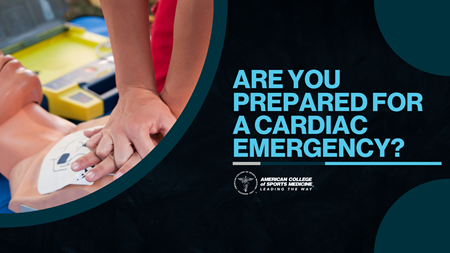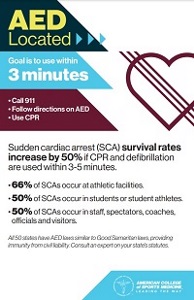Joe Sherlock, ACSM Copywriter |
Aug.
12, 2022

The benefits of physical activity, even at low levels, far outweigh the cardiovascular risks for most people. But Murphy’s Law is always peering around the corner — what if the worst happens? We need to have a plan in place.
The risk
First things first: Though light- and moderate-intensity physical activity seem to show no greater risk of causing cardiopulmonary issues than do resting conditions, vigorous physical activity does come with an increased risk of adverse cardiopulmonary events. Luckily, these incidents are relatively rare, but they do happen. As for the causes, they may differ depending on a person’s age and sex:
For instance, many younger people who succumb to sudden cardiac death may have had a congenital heart issue (though this isn’t always the case). For those over 40, most autopsies showed that atherosclerosis was likely the cause.
Sudden cardiac death also appears to be more common in men than women — to the tune of a 15- to 20-fold increased risk for men during or post exercise when compared to their female peers. However, the rates of heart attacks themselves — not necessarily sudden cardiac death — appear to be the same in men and women, so we shouldn’t discount heart issues just because someone is female.
A reminder
Despite the dangers listed above, physical activity is generally beneficial for cardiovascular heath, and overall, most people are better served by exercising than not. It’s important to keep this in mind as we discuss adverse events and how to prevent them. We’re thinking about worst-case scenarios, not the everyday norm. There is an enormous difference between being fearful and being prepared.
The response
If you operate or work at a health or fitness facility, you need to have an emergency plan in place — not just a response you’ve discussed casually but a well-considered strategy set down in writing. And don’t be complacent: Review your plan each quarter, and do a full-scale practice run at least twice a year. Like exercise, you’ll see improvements if you put in the time.
And get your individual emergency training in: Make sure you and other staff members are skillful and properly certified in first aid, CPR and the use of AEDs.
Speaking of AEDs, or “automatic external defibrillators,” you absolutely need to have one on hand. AEDs are sophisticated but easy-to-use instruments that measure heart rhythms and if necessary provide an electric shock to restore the heart to a proper cadence. People are most likely to survive a cardiac incident if they receive CPR and AED assistance within five minutes — even better if the response time is under three minutes. See if you can whittle your response time down a little more each practice run.
If you can, get a physician involved when setting up your AED and your overall emergency response plan. And make sure you have the proper signs in place so that people can easily find your AED and other first-aid equipment.
In sum
Though cardiovascular events related to exercise are relatively rare, they do happen, particularly during vigorous exercise. It pays to be prepared with a concrete and well-practiced response plan and equipped with the right training and technology. We have the knowledge and tools to avert tragedy, so let’s make sure we make use of them.
 Click here to download this free AED resource poster!
Click here to download this free AED resource poster!